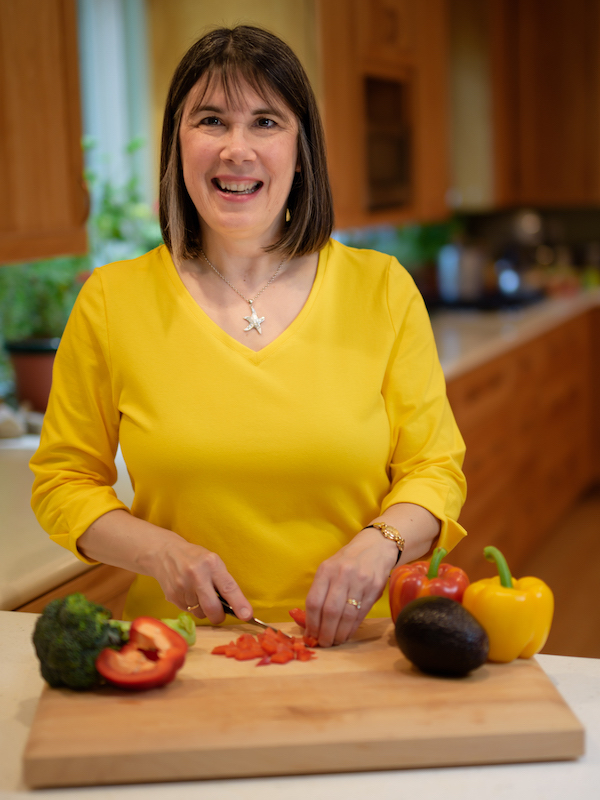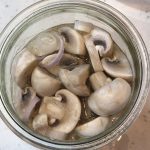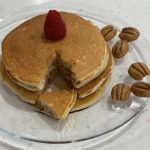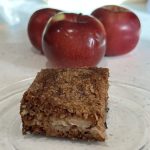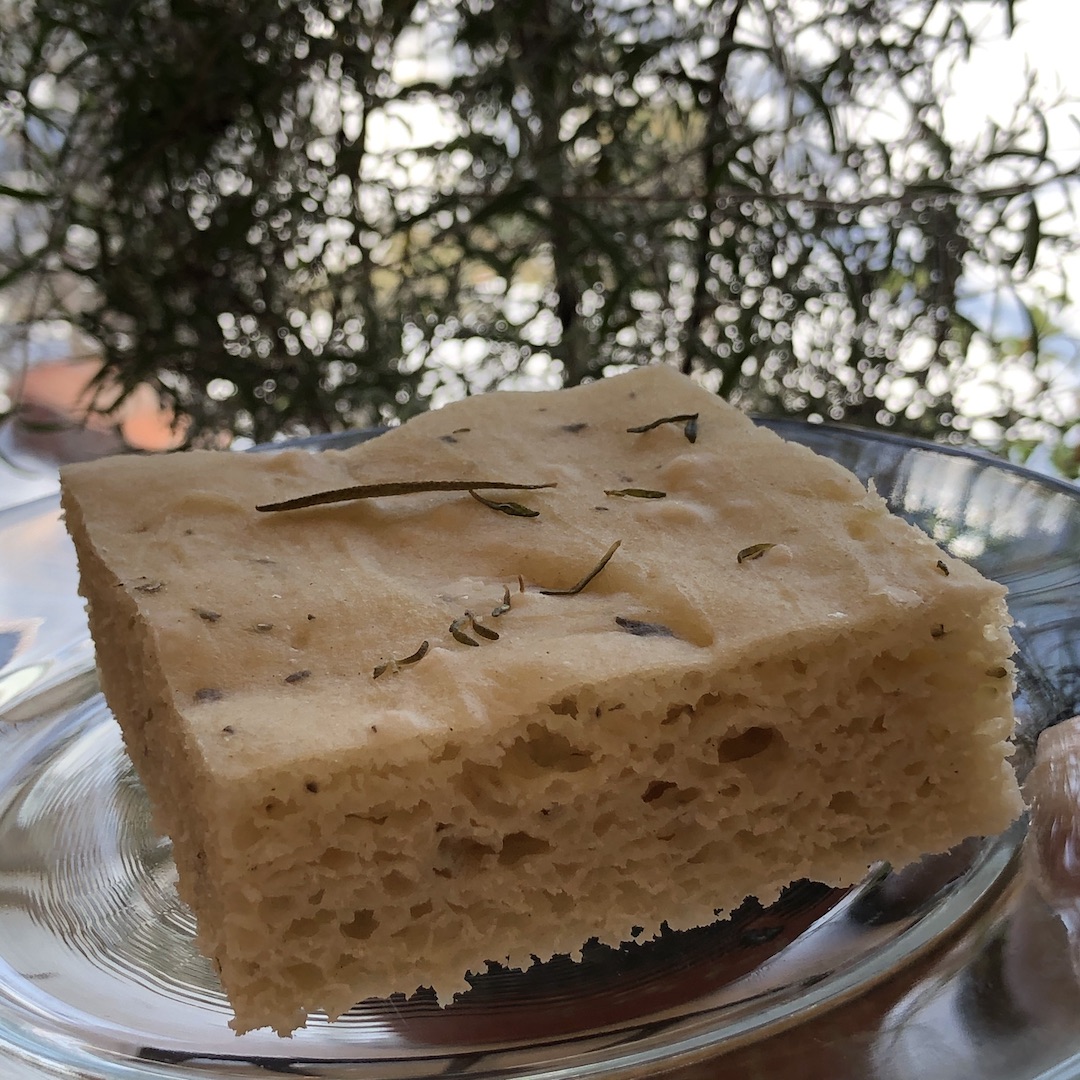
The Cooking Framework Quiz is available by clicking the button below.
Don’t miss an episode!
The button below will take you to Apple Podcasts to subscribe.
Or visit your favorite podcast provider to subscribe.
Thank you!
Resources
Debra’s website Modify life . . . simple modifications, significant transformation
Zojirushi Home Bakery Virtuoso Plus Bread Machine – here is one from King Arthur Flour’s website that has the gluten free setting.
Transcript
Welcome to The Sensitive Kitchen where home cooks are inspired to Cook to Enable Those You Love to Flourish.
I’m Cindy Sullivan, registered dietitian, passionate nutrition educator, and accomplished home cook. Whether you’re changing how you cook for food sensitivities, allergies, intolerances, or just trying to eat healthier on a budget, you’re in the right place. Most episodes, I will share favorite recipes as well as modification tips, and nutrition benefits. Occasionally I’ll have a guest or special episode like modifying holiday favorites.
My favorite foods? They’re raspberries and homemade chocolate chip cookies. My latest cooking project was long fermented sourdough bread.
I am so glad you are here with me today. I want to share an interview with you I did with Debra Prince who I feel could almost be my cooking twin. She has lots of fruits and vegetables in her life. Lots of whole foods. She cooks almost everything that her family eats. She has amazing baking tips to share with you, talked a little bit about saving money because as you know, cooking for food sensitivities can be an expensive proposition, freezing food. She does a lot of the things I do.
She has a great website, modify life, simple modifications, significant transformation. I love that, but after we ended the interview, Debra and I were chatting a little bit about how easy it can be to get into a cooking rut, eating the same thing over and over. And this is for those of us we’ve been doing this both of us for almost 20 years, or for me a little bit more than 20 years.
So I want to share with you about the kitchen table membership that we’ll be launching later this spring. You’ll hear more about it in the weeks to come. But two key aspects I want to talk to you about today. One is the sense of community. Where do you go for help? Where can you get your questions answered?
Where can you share some successes? Hey, this really worked great. You want to try this? Where do you share your ideas? You’re not in this alone. It’s hard to cook all the time for food sensitivities. And so a real sense of community. I’m really excited about that. The other are challenges and it almost monthly we’re going to have challenges where you can find new recipes that work for your family.
Maybe one month we’ll do soups, another month we might do breakfast, another month we’ll have a variety of different things. Everybody won’t be cooking the same recipes because you need to know what works for your food sensitive family, but we will all be cooking. We’ll all be encouraging each other, working to find new recipes so that we can Cook to Enable Those We Love to Flourish. Let me let you hear my interview with Debra. It was amazing.
I am so pleased today to have Debra Prince with me today. And I will let her introduce herself. Tell us a little bit about you before we get into your food journey, which we’re going to do in a minute. Tell us a little bit about you,Debra.
Debra: Well, first of all, Cindy, thank you for having me today. And I think it’s a privilege to share my experience with those who might be newly diagnosed or who have been diagnosed with food sensitivities sets activities or food allergies or auto-immune disorders, and are looking for new information that can make their life easier, simpler and more enjoyable. A little bit about me.
I live in Colorado, originally from California and I started writing about information I could share with the world through my website, modify and make life simple. A couple of years ago, I was diagnosed with an autoimmune disorder back in 2003. And since then, I have tried to find ways to eat healthy, to eat in a way that supports my autoimmune disorder of celiac disease and at the same time, be able to enjoy life as a wife and a mom and a business person as well. So that’s a little bit of information about me.
Cindy: That’s awesome. Thank you. Tell us a little bit about your food journey. How do you cook now? How did you end up here? Tell us a little bit about that if you would.
Debra: Absolutely. I make pretty much everything myself in my kitchen. I make my own bread. Once a week, I use the, a bread maker that has a gluten-free setting. I’m going to probably really mess up the pronunciation here, but it’s a Zojirushi bread maker and I make my own bread because when I’ve gone to the stores and I’ve purchased gluten-free bread already made, sometimes it might have corn in it and I can’t do corn either. I’m also lactose intolerant. So this allows me to control the ingredients in the breads that I eat and also to control the expense. I have paid $10 for a loaf of bread only to get through a few slices and then it has holes through it. And I can’t really use it for a sandwich or for toast.
So I find it a lot easier just to make it myself. As far as the rest of the baking, I do my own cookies. I’ve been able to take traditional recipes. My mother’s originally from Croatia, my father’s family’s from Malta. So we have a lot of European, a lot of Italian influence dishes that we make. And I’m able to take those traditional recipes and enjoy them: gluten-free, corn free, and again, control the ingredients. So that is where I am today. I do a lot of my own baking and cooking. As far as cooking goes, you know, my allergies aren’t affected so much by eating chicken and fish. I don’t eat beef, I don’t eat pork, but for the most part, cooking is easy.
Pastas, I’ve had an opportunity to try all the different pastas on the market. Cooking gluten-free it’s impossible, but I haven’t actually given a lot of effort to learn how to make my own pastas, but I have found Barilla to be an excellent option for making pastas. But for the most part, I eat healthy. I eat whole foods. I don’t eat a lot of processed foods and I do a lot of it on my own.
The journey has been interesting when I was first diagnosed in 2003, there wasn’t a lot of options in the marketplace. So it wasn’t a lot of, you know, like today we have all purpose. Gluten-free flours with the example of gum already in it back then you didn’t have that as an option. What I was able to buy was pretty much at trader Joe’s and it was that rice bread that was as hard as a brick and the slices were really small and that was pretty much all I had.
So I didn’t eat breads and I didn’t eat my cookies or anything like that. So I’ve had to learn a lot of them. At the time my doctor referred me to a dietitian nutritionist and she came to the house. It wasn’t her fault when there’s not a lot of options in the marketplace, she really can’t tell me what I can do. And so it ended up being an hour session of everything I cannot do.
So it was pretty much on my own and learned how to eat very healthy. We always ate healthy on our, in our home. Anyway, it was always whole foods, whole foods, pure foods. So that was an easy transition. I’ve always had a diet that was very heavily focused on lots of vegetables and lots of fruits. So it was probably easier for me than I think most people who didn’t already have that foundation.
And, and so that was good thing, but it is an opportunity to one learn how to cook well. And secondly, how to, how to accept that when you try something for the first time, you’re probably gonna have to throw it away. You know, it’s, I’ve thrown a lot of dough away. I’ve thrown a lot of finished products away, but eventually you get there. So this whole journey has been also a very good lesson about patience.
Cindy: Sounds great. And yes, we have eaten that trader Joe’s Brown rice hard-as-a-rock bread in my house many years. And I love my Zojirushi bread machine. I adore it. I adore it. I adore it. So we will definitely stick a link someplace.
I don’t even get into affiliate commission on it or anything. It’s just an amazing machine. And I do, I love mine.
Debra: I’ve had mine for, I want to say 10 years or longer. And it still works like a charm.
Cindy: Yeah, this is my third one, but that’s over 30 Years. Yeah. It’s great. Tell me a little bit about your biggest challenges. Now I know that when you began this almost 20 years ago, there was not a lot out there. What are some of the challenges you mentioned, sometimes things don’t turn out exactly how you expect, which is always a challenge. Tell me a little bit about what are you surprised about? I think you said the corn was new, so there’s some, perhaps some new challenges that you’re not used to with the gluten-free, all of a sudden your corn free.
Debra: Exactly. It was last year. I I’ve always had problems with acid reflux, so it probably started in 2006. And then last year I had an, an issue where I couldn’t swallow the acid reflux was so bad and I thought it was just because I was going through a whole lot of stress and life challenges at the time.
And I went to my internist who of course wanted to prescribe antacid kind of prescription medication. And I’m not big on prescriptions unless it’s really, really necessary. So I had to think back what changed in 2006, because I had a backtrack to when I first had the symptom, well, I was on a gluten-free diet 2003. So after a few years I realized I was eating a lot more corn based products.
And so I thought maybe I have an aversion to corn. And that’s huge. That’s when my acid reflux all began. So I went on a corn free diet last year and my symptoms went away within a few months. When I had my endoscopy last June, the doctor said that was the clearest he’s ever seen my esophagus since I started having endoscopies. So now I had to change my diet for sure.
I had to make sure nothing had corn in it. Well, it’s amazing. Corn is in everything. People don’t realize it. My favorite brand of flour is cup for cup gluten-free flour, but the first ingredient on it is corn starch. So now I’m having to switch to what I like is King Arthur’s measure for measure flour, but it’s denser.
It’s first ingredients are all the rice flours and the Brown rice flours. So that means it’s going to be denser. And this is something good for the audience to know if you’re making breads. And you’re noticing that it’s too dense. Look at the flour you’re using. And at the first ingredient are all the grains that are gluten-free grains, but still all grains, it’s going to be denser.
So I had to take King Arthur flour, that’s gluten free. And if it, if the recipe calls for three cups of flour, then I will use two half cups of the gluten-free flour and I’ll use a half a cup of potato starch, and that gives it more of a fluffy better bread consistency rather than the dense.
So that has been a challenge when you are diagnosed with another food sensitivity or allergy, that you have to really start reading ingredient labels all over again, to be sure that it does not contain what you’re sensitive to. The other big challenge – and it’s an ongoing challenge for me – has been how expensive it is to change your diet for such issues as gluten-free or corn free.
And I’m going to give an example, cause I did a little price analysis. So if I buy five pounds of King Arthur, all purpose flour at the grocery store in our local grocery store here in Colorado, it’s $5 and 49 cents a bag. If I buy the King Arthur gluten-free flour that comes in a three pound bag, the cost is $11 and 99 cents.
If I didn’t have to be on a gluten-free diet, I could go to Costco and I can purchase for $7 and change a 25 pound bag of unbleached, all purpose flour. So it is very expensive to be gluten free it’s I could go through a three pound bag, very easily of flour. And, and so I have found a workaround that makes it a little less expensive that I’ll also share.
The other challenge has been recipe books. When you’re compensating for certain ingredients you can’t have, oftentimes the recipe becomes so heavily laden with fats and sugars, and then it makes for unhealthy eating. And so it’s always good when you’re following a recipe and it seems to have a lot of fat and sugar bake it or cook it the way the recipe calls.
So at least, you know what it’s supposed to look like, what it’s supposed to taste like. Then the next time you make it starts scaling back on the butter and start scaling back on the sugar and maybe using Greek fat-free Greek yogurt instead of two cubes of butter or one cube of butter and, you know, making up for the measurement of using non-fat Greek yogurt,
Look at what other alternatives are. It’s very easy to go online and say, give me an alternative for and list the ingredient you want to substitute. There’s lots of substitutions out there. Look for a substitute for corn starch. Look for substitute for again, other ingredients you might have an aversion to and practice and absolutely just practice.
The other challenge has been, especially in the gluten-free arena, there are other flour that are coming out as a substitute for wheat. One of them is cassava flour, and this is so important, Cindy, I tried cassava flour three different times and all three times I got extremely ill. It wasn’t until the third incident that I decided I need to look at the ingredients and find out where, what the common denominator is here, because I don’t want this to happen again.
And it was cassava flour. I contacted the manufacturer of these chips that were grain-free gluten-free and we talked about it. They were so helpful. Well, cassava flour is made from the root of the tapioca plant. It is not the same as, as tapioca flour or tapioca starch.
The root has a lot of toxins in it. It has to be cleansed and processed in a certain way. Whereas tapioca flour and starch is really just starch from the plant itself. Something about the process, either some toxins come through or the process itself, what is used to cleanse the tapioca root I can’t do. When I looked it up online, apparently those who have celiac disease, this is not an uncommon reaction. It is not just my reaction.
So a challenge has been whatever your food sensitivity is or auto-immune disorder or food allergy know that there are times things will come out in the marketplace that’s new to our country, not necessarily new to other countries. Cassava flour has been around in South American Africa for many, many, many years and generations.
Just know when you have a reaction, go back to basics, go back to the ingredient lists, start seeing where there’s a common denominator, because you’re going to have to take care of yourself. You can’t depend on what other people claim on a package labeling. You have to be your own advocate and responsible for yourself. So those are my challenges for sure.
If you’re looking to save money, the best way I have found is to do the subscribe and save through Amazon. So instead of spending $17 a bag, for instance, on the King, on the, a cup for cup multipurpose flour, I can get it for $11 and 36 cents through Amazon’s subscribe and save. So that is one of the options in order to save money.
Cindy: And you’re right. Saving money as I was going to come back to that too, is a huge thing for people because all of a sudden their grocery bills go way up. A couple of things that I encourage them about though, is that probably at least for a while, you’re eating out bills are going to go down. So you’re sort of transferring your, you’re not eating out as much, you’re cooking more. So you’re sort of transferring that money hopefully into your grocery budget.
And if you’re willing to put some time in and cook, it’s a lot easier and cheaper to cook a lot of these things yourself. That doesn’t mean it’s, it’s inexpensive as eating whatever you want, but the time to do that.
The other thing as a dietician that, that gets me on some of them, and you mentioned it already, is when I look at some of the ingredients and some of these things, for example, it took me years to try to get my family, and I worked really hard to get them in a lot of whole grains. And then when I looked at a lot of the gluten-free flours, it was, or not only just the flours, the products that were on the market, they were all refined. And I was, my heart kind of sunk.
You know, that doesn’t mean it has to be that way, but you kind of have to do a little bit of, we do a gluten-free cake, cupcake loaf kind of thing in my house that’s made with quiona and a blender, you know? So at least that’s a whole grain, but it’s hard to, you know, those are hard to find.
Debra: Yeah, they are hard to find more and more products are hitting the shelves. Again, still check the ingredient, labels yourself, and it’s okay to contact the manufacturer. Usually there’s an email address. They’re usually very helpful. Don’t think you can’t, if you’re listening to this podcast, please do contact the manufacturer if you have any questions.
When I had contacted the manufacturer about cassava flour, the last thing they want is for anyone to have an aversion to their products. They don’t want that just as much as you don’t want that. So that’s really important to know.
Cindy: Yeah, exactly. You’ve already given us so many wonderful, helpful tips. Are there some other ones that you have about cooking for gluten-free, corn free that, that you to share?
Debra: Yes. I do have some tips that I wrote down. And so I’m going to read these because I didn’t want to forget anything most important. The thing I think that it’s good to know, and I put it first on my list is when you’re starting to use new ingredients, different ingredients, get used to the idea that the consistency of the dough is going to be different.
This is not a glutenous stretchy dough that you can, you know, need and, and roll. And it’s perfect and beautiful. It’s not going to be that way. And so you need to accept different and different for gluten-free is a very soft dough, almost wet dough. It almost looks like a batter, accept it, be okay with it. Don’t try and make it something that it’s not.
And here’s some other good tips I’ve learned through the years when baking yeast bread also add a half teaspoon of baking powder per what would be per loaf to the recipe. It will give it more height and less density when the bread is finished baking and that’s, that was a really good tip to know.
And then after baking, and this is whether it’s in the bread maker or you’re doing it in your oven, once the bread completely cools, and usually I give it the remainder of the day to cool, I slice and freeze because this way, well, at high altitude, I’m at high altitude everything goes bad pretty quick.
So by slicing and freezing, I know I always have plenty of sliced bread that I can take out either the day before to use the next day, or I could just put it in the toaster as I’m ready to eat it. Otherwise, what happens is you run out of bread and then you’re starving and you run to the store, you buy a loaf of bread, you pay $10 for it. And you find that has holes all through the center of it. And that’s, that’s not good too. Cause now you’ve wasted money and you don’t have anything really good to use.
This is not a good thing on a keto diet. And what they do post usually is gluten-free so check keto websites for ideas there. Again, I’m going to go back to baking yeast breads, add one teaspoon of Apple cider vinegar to the recipe. I’m not a chemist. I don’t know why this works, but it does. And it helps you don’t get the Apple cider vinegar tastes, but it just helps the bread have a better consistency, more towards regular bread than a dense loaf of bread.
Cindy: I’m going to guess it’s going to interact, especially with some of the baking powder and things to give it more, I am, my background, my undergraduate’s in chemistry, so I’m going to guess it’s going to give you more air to lighten it a little bit would be my guess.
Debra: Yes, I would agree. That probably is that. So thank you Cindy, as a chemist background for that. And also I have found it is better and I know we just talked about how expensive it is and how to save money when you are cooking differently, but it is better to pay more for certain flours than not because it’s going to be a better quality.
And it’s going to give you a better result in the long run. It’s probably going to save you money rather than going with the cheaper version. So that’s also good when making pizza dough, I have craved pizza. My mother used to make the best pizza as well as the best foccacia bread. When baking pizza and you want a good pizza crust, add an extra egg white to the recipe.
And that’s something I also found out about when baking cookies and especially in the recipe of baking biscotti. And I already noted this in my recipe – let the dough rest for 30 minutes before shaping and baking. My mother’s cousin is the one who gave me the suggestion because I would have such trouble rolling my biscotti dough.
It would fall apart and it would just take so long. And I went to her and said, I need help. And on the Croatian side, they’re amazing cooks and bakers. And so she said, honey, just let it rest for thirty minutes. And that little tip make the biggest difference because after 30 minutes I could roll it so quick and get it in the oven. So it was perfect. And I would say that would be, those are my tips.
Cindy: Those are amazing tips. Thank you so much. I also bake all of our bread, but my husband’s only wheat sensitive. He’s not totally wheat free. So I do a long fermented sourdough that he can tolerate. You can’t do that. But I also had for years baked all of our bread and it’s a totally different thing when you do gluten-free.
I mean, it just is a different doesn’t mean you can’t do it. And I agree. My freezer is my friend and your friend and everybody’s friend, because you can make double dinner, throw it in the freezer another day when you don’t have time to cook, pull it out. Right. One of my very best tips.
Debra: Exactly we use if two freezers and they’re always full. One drawer is just for breads and cookies. Just one drawer dedicated to that.
Cindy: And I am so excited Because you have two recipes that you’re willing to share with my readers today. Tell me about those. One is a biscotti and one is focaccia. Tell me, pick one start first.
Debra: Okay, well, let’s start with the Biscotti recipe. I, at one time back in around 2002, 2001, 2002, I had started my own biscotti business and it was difficult. Then we had an economic downturn. And so what was starting to really track, I had to pull back and close down, but I grew up with Biscotti and it was always served at holiday get togethers and celebrations. And so I thought, wow, I can’t live without it.
I mean, it’s just part of who we are. So I spent a lot of time and lots of dough that got thrown away in order to make the perfect recipe. And again, also talking with my mother’s cousin and how to really perfect it. And so the recipe that I’m sharing is a peppermint chocolate chip biscotti. It is very popular around whenever I make it.
There’s usually no leftovers and it’s perfect gluten-free. I freeze my biscotti and you can then take it as you want it out of the freezer. And it’s perfect. So I highly recommend that whenever you’re doing any baking, you can take that traditional, that biscotti recipe. And instead of using peppermint extract, try orange extract with a little all spice seasoning or try lemon and extract and changing the flavor with white chocolate drizzle.
So on my website, I list I think four different biscotti recipes that I encourage all the listeners to visit and to try it as well. So that’s a little bit about the biscotti recipe.
Cindy: Sounds wonderful. I can’t wait to try it. It sounds great. I love chocolate and peppermint together, so it’s great.
Debra: Just a little dark chocolate on top of the cookie or why chocolate is excellent and makes it real pretty, especially for the holidays. On the foccacia recipe. My mother used to make the best and made it for all special occasions as well. We lived in San Francisco. So when she did make it, there was a bakery, I think it’s still around that that also made the best. And if you lived in San Francisco foccacia is, you know, just a staple, at least for everyone that we, we lived around. And so I wanted to make my own, and that was a lot easier.
The difference is, it is very wet. It is very soft. So once it’s, it looks like a batter, it goes into the pan. You just sprinkle some gluten-free flour on top, and then you press it down with your hand and bake.
So that is also one of the favorites. I make these two recipes all the time at social, get togethers, at least pre COVID-19 to share with my neighbors.
Cindy: Yes. Oh, those sound wonderful. I know my listeners will enjoy them and I can’t wait to try them as well. People are going to be excited in my household.
Cindy: That’s awesome. And I will mention to my listeners that as usual, the podcast episode, the transcript, the recipes will be on my website. That’s food sensitivitykitchen.com/018. This is episode 18, and I will also be linking on that one under the resources to Debra’s website as well as, and you’ll want to check out some of her other recipes there, I know when you’re there as well. Debra, thank you so much. Thank you for coming on the podcast for sharing your expertise and what wonderful tips that you’ve been able to give our readers, especially some of those just starting out, but actually some seasoned gluten-free bakers. I bet learned some things today too.
So thank you so much for your time. And for sharing your expertise, do go to Debra’s website, check it out. The link will be on food sensitivitykitchen.com. Thank you so much for listening today. Keep Cooking to Enable Those You Love to Flourish. Have a great day. Thank you. Bye bye.

